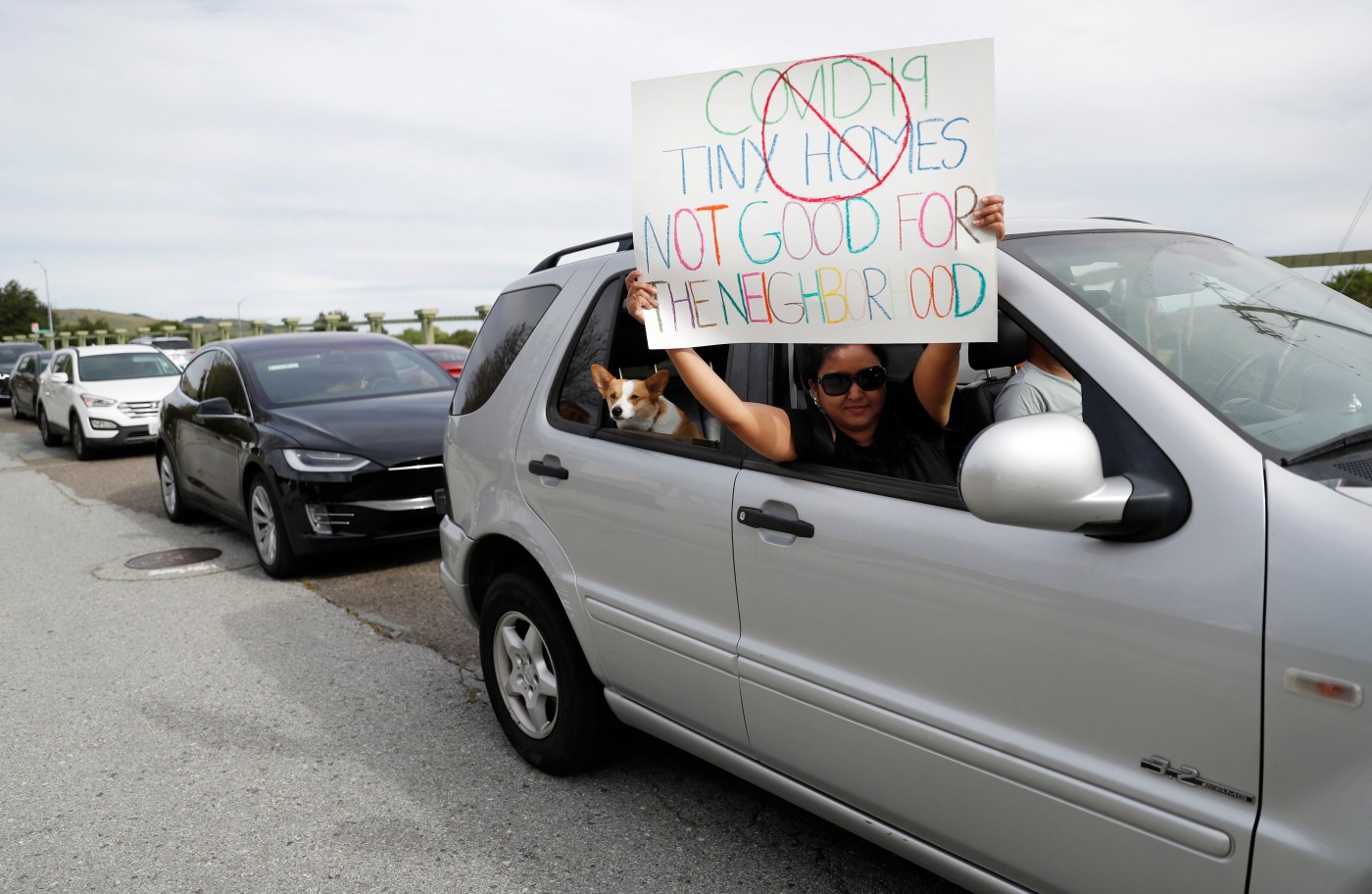Community backlash over a Santa Clara County proposal to purchase a San Jose-owned interim housing site for a jail diversion program has left officials looking for another opportunity to assuage residents’ mounting public safety concerns.
However, their latest attempt to engage neighborhood leaders from South San Jose’s Districts 2 and 10 on Tuesday night may have made problems worse. The county is accused of circulating a flyer that infuriated residents from the surrounding area who described it as “misleading,” “deceitful” and “insults their intelligence.”
“The County wordsmithed ‘jail diversion’ out of the description of the program,” said George Casey, a candidate for City Council and a resident of District 10. “This is disingenuous and disrespectful, a second slap in the face that I don’t believe the community nor the city should tolerate.”
County officials had hoped to use two grants from the California Health Facilities Financing Authority to facilitate the $8 million purchase of the tiny homes near Monterey and Bernal roads that can accommodate 78 people, and another site on Vermont Street.
During last week’s Board of Supervisors meeting, Deputy County Executive Ky Le said the county’s plan would help San Jose leverage its housing funds to create a better treatment environment for who are being connected to services. Along with the $8 million the city could use for affordable or interim housing solutions, selling the property would save San Jose at least $2.5 million per year in operating costs.
The grant terms indicate the sites should be operational by the end of November, which upset residents who first heard about the proposal at a mid-August community meeting held less than two weeks before City Council members were scheduled to discuss the sale agreement.
District 10 Councilmember Arjun Batra requested a delay and has since vowed to block the sale, saying he was also blindsided by what he called a “dangerous proposal.” During budget sessions earlier this year, city staff had mentioned the possibility of the sale, with Budget Director Jim Shannon saying, “They would be operating them for the same purpose,” during a May 8 meeting.
The plan initially outraged hundreds of residents, who rebuked the city and county for a perceived lack of transparency and for not addressing their public safety concerns. The county then agreed to host another community meeting on Sept. 11, only to face more pushback for how it described its proposal.
“Nowhere on the flyer does it mention (a) jail diversion program,” said Los Paseos resident Karen Lattin, who noted while she was typically supportive of homelessness solutions, the facility as planned would pose “a serious threat to the three residential neighborhoods, schools and shopping center nearby, considering that it will be an unlocked facility.”
“Similar to the original flyer that presented the community meeting as a ‘Meet & Greet” to break the news to us that this facility was being sold to the county to become an unlocked jail diversion facility, the flyer is filled with euphemisms to refer to a program whose target population of 78 residents will be dealing with 3-4 extremely difficult situations–homelessness, combined with mental health issues and/or addiction issues, combined with a history of criminal behavior,” Lattin said.
San Jose Mayor Matt Mahan said while the county was well-positioned to operate transitional housing sites, he shared the community’s concerns.
“Our understanding from the outset was that the county would continue to focus on getting our homeless neighbors off the streets and offer then a path toward self-sufficiency,” Mahan said. “I look forward to getting greater clarity on the county’s proposal at the upcoming community meeting.”
In response to the latest salvo, county officials said they valued open and honest communication and were willing to listen to residents’ concerns. But lost in the county’s messaging thus far has been its belief that the site’s clientele will not change much.
“It’s important to know that the proposed use at 6066 Monterey Road is not a significant change from the current use,” the county’s Behavioral Services Department said in a statement to The Mercury News. “The site has been a safe haven for people facing behavioral health challenges and those who have had some involvement with the justice system. It will continue to offer temporary shelter and support services to unhoused men and women, helping reduce unsheltered homelessness in our community.”
A spokesperson said that while the sites would have full-time security, diversion program participants would need approval from the courts and the offices of the District Attorney and Public Defender. The county also noted that the state’s penal code mandates that participants in diversion programs must “not pose an unreasonable risk to public safety,” as determined by the court.
Related Articles
This Bay Area county made refusing a shelter bed a crime. Is it helping solve homelessness?
San Jose begins clearing part of troubled Columbus Park homeless camp
While building ‘Camp Hope’ in Martinez, she lost $125,000 to a burglar who had sought her help. Now this former vice mayor is ready to do good deeds again
Does sleeping on the street make this disabled Bay Area Marine Corps veteran a criminal?
Recent Oakland homicide victim was among those who sued to stop state from clearing them out of homeless encampment
The Board of Supervisors also addressed the proposal during last week’s county meeting, including the need for alternatives to incarceration, which they said is often intertwined with homelessness and only perpetuates the issue because it offers no long-term solution.
“Concerns about the population demographic of future residents should be addressed, particularly if those residents are justice-involved or formerly justice-involved or formerly unhoused,” Board President Susan Ellenberg said last week. “But if we allow those concerns to preclude projects from moving forward, we aren’t going to address the very goals the community says they want us to achieve.”












